Zoology Final Exam
1/63
There's no tags or description
Looks like no tags are added yet.
Name | Mastery | Learn | Test | Matching | Spaced |
|---|
No study sessions yet.
64 Terms
Annelid: What is a worm?
Animals that do not have legs, aren’t covered by a shell, are not deuterostomes, and do not have a lophophore
Soft bodied
They are longer than they are wide
Can be flattened or round in cross section
In other words, an animal that is 2-15x longer than wide
Classes within annelids?
They were traditionally 3 classes including Oligochaeta but now we only have 2 due to phylogenetic analysis. (polychaeta, Oligochaeta, hirudinea)
Polychaeta: have parapodia, are marine worms
Clitellate: have a clitellum
2 subclasses are oligiochaeta (earthworms) and hirudinea (leeches)
Characteristic of Annelid
10,000 species
Triploblastic
paired epidermal setae
Bilateral
Metameric body (repeated segments)
Closed circulatory
Complete digestive tract
They do possess a coelom
What is metamerism?
The segmentation of the body into repeated units called metameres or segments, which can contain repeated organs or structures. Found in annelids, arthropods, and chordates
What is tagmatization?
Specialization of body segments into distinct functional regions called tagmata. It is a result of metamerism.
Advantages of Metamerism?
Segmented muscles allow for more precises and flexible movement
Repetition of organs in segments means that if 1 is damaged, others can still function
Segments can become specialized for different functions
Aids in efficient growth and development
What is the septum in metamerism?
A thin internal wall of tissue that separates one body segment from another.
Annelid: Class Polychaeta
5,300 species
Largest annelid class
Marine
Cephalization in most
Parapodia
Well developed setae
Can be mono or dioecious
5-10cm long, can be much longer
Predators, herbivores, deposit, filter feeders, and parasites

What is the parapodia?
Paired, fleshy, lateral appendages found on each segment of many polychaetae annelids. Helps the worm crawl or swim, acts as a sensory structure, can contain setae (bristles) for grip and traction. Often divided into 2 lobes.
Dorsal lobe: notopodium
Ventral lobe: Neuropodium
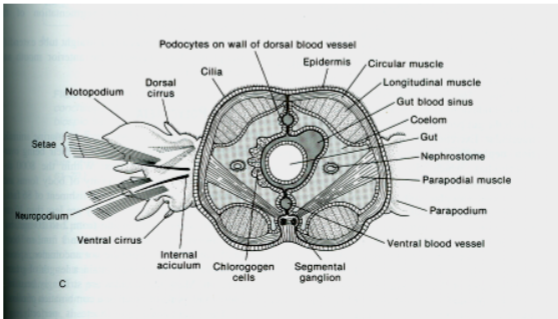
Polychaetae Cross Section

Polychaetae Anatomy
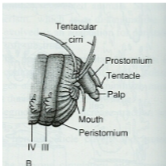
Annelid: Polychaetae Locomotion
They can swim, crawl, and burrow.
Crawling: via alternating movement of parapodia and body segments
Swimming: Rapid body movements with parapodia aiding propulsion
Burrowing: Using coordinated contraction and anchoring by pushing or eating away at substrate
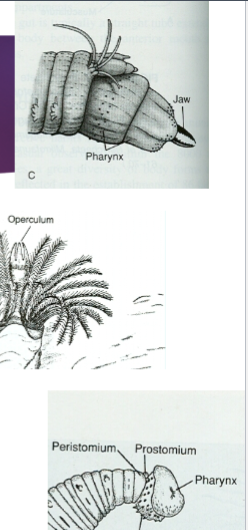
Annelid: Polychaetae Feeding
They have a modified head region in order to feed
Predators: use a proboscis (can be turned inside out) with jaws or teeth to capture prey
Filter feeders: Use ciliated tentacles or palps to trap food particles from water, mucus helps trap them as well.
Deposit feeders: Ingest sediment and extract organic material using tentacles or modified parapodia to gather food from substrate
Herbivores: Graze on algae growing on sediment, uses rasping and scraping
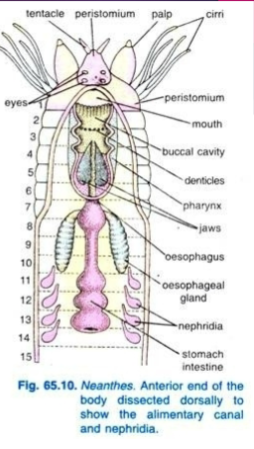
Annelid: Polychaetae Digestion
Polychaetas have a complete, straight-tube gut that runs from mouth to anus, and they use extracellular digestion to break down food.

Annelid: Polychaetae Gas exchange and Circulatory
Gas exchange: Across body wall, parapodia, some have gills. Occurs primarily across the body wall and parapodia, which are well-vascularized and often thin enough for diffusion.
Circulatory: Closed system with dorsal & ventral aorta, segmental vessels, capillaries
Respiratory Pigments: Hemoglobin, hemerythrin, chlorocruorin aid oxygen transport
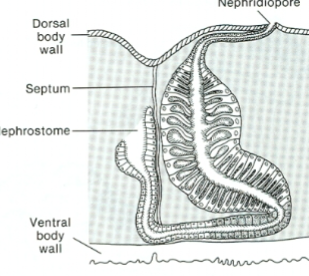
Annelid: Polychaetae Excretory
Excrete ammonia mainly by diffusion through their body surface. They regulate water and ion balance using excretory organs called metanephridia, with one pair per segment. Each metanephridium has a nephrostome that collects coelomic fluid, a tubule system for processing, and a nephridiopore for waste release.
Annelid: Polychaetae Nervous System
Paired suprapharyngeal (above the pharynx) and subpharyngeal (below the pharynx) ganglia. A double ventral nerve cord runs along the body with paired segmental ganglia in each segment.
They possess various sensory organs including simple to complex eyes, nuchal organs (chemosensory), statocysts (balance), and tactile sensors for environmental detection.
Annelid: Polychaetae Reproductive System
Sexual: Gonads form from the coelomic lining and gametes mature in the coelom. Gametes exit the body through nephridia or by body wall rupture. Fertilization is mostly external in the water. Many produce trochophore larvae, though direct development is also common.
Asexual: Some species reproduce asexually through epitoky. A specialized reproductive form (epitoke) is produced asexually. Epitokes swim to reproduce, while the original worm (atoke) stays safe. This ensures timing and location of egg and sperm for successful fertilization and avoids predators.
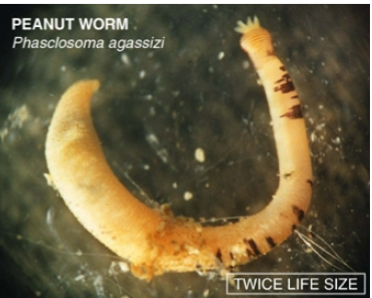
Annelid: Subclass Sipuncula basic characteristics
Peanut worms
320 sp.
Triploblastic
Organ level
Bilaterally symmetrical
2 mm to 72 cm
Benthic marine
Live in burrows
Nonselective filter or deposit feeders
Two coelomic cavities

Annelid: Subclass Sipuncula Systems
Digestive: Complete and J-shaped
Circulatory: No blood vascular system, the coelomic fluid performs circulatory functions, blood pigment is hemerythrin
Gas exchange: Diffusion
Excretory: Nephridial funnel is coelom
Nervous: Dorsal brain, ventral nerve cord, sensory cells in introvert
Skeletal: Hydrostatic
Muscular: Circular and longitudinal muscles
Reproductive: Dioecious, external fertilization, direct development
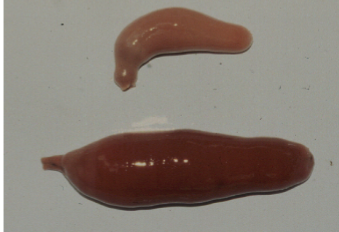
Annelid: Subclass Echiura Basic Characteristics
Spoon worms
140 sp.
Triploblastic
Organ level
Bilaterally symmetrical
Benthic marine
Filter feeder or deposit feeder
1 cm - 50 cm
Found shallow water and deep sea
Annelid: Subclass Echiura Systems
Digestive: Complete, long, and coiled. Intestine is where digestion occurs
Gas exchange: Across general body surface, water lung in urechis
Circulatory: Present in all but urechis, coelomic fluid serves as circulatory, hemoglobin present in urechis
Excretory: Anal sacs, may or may not have excretory functions
Nervous: Nerve ring around proboscis, no specialized sensory organs in adult, ventral nerve cord
Skeletal: Hydrostatic
Muscular: Circular and longitudinal muscles, locomotion by peristaltic waves
Reproductive: Dioecious, external fertilization, gametes mature in coelom, removed by genital sacs, trochophore larva

Annelid: Subclass Pogonophora Characteristics
Bearded tube worms
80 Sp.
Triploblastic
Organ level
Bilaterally symmetrical
No digestive tract
All marine
5 cm to 2 m
Tend to be deep sea
Greater than 1000 meters in depth

Annelid: Subclass Pogonophora Systems
Digestive system: No digestive tract, mouth or anus
Circulatory system: Blood vascular system, Hemoglobin 30x larger than human, Coelomic fluid
Gas Exchange system: Plume acts as gill
Excretory system: Nephridia Function unsure
Nervous system: Ganglia at base of plume, ventral nerve cord Skeletal system: hydrostatic
Reproductive system: Dioecious, Gonads in trunk coelom, Trochophore larvae
Annelid: Class Clintellata Characteristics
3,000 species
Earthworms and leeches
Clitellum
No parapodia
New or not setae
Monoecious
Direct divelopment
Annelid: Class Clintellata Subclass Oligiochaeta
3,000 species
Earthworms
Primarily terrestrial or freshwater
Few setae
No distinct head
Scavengers
No sensory structures or prostomium
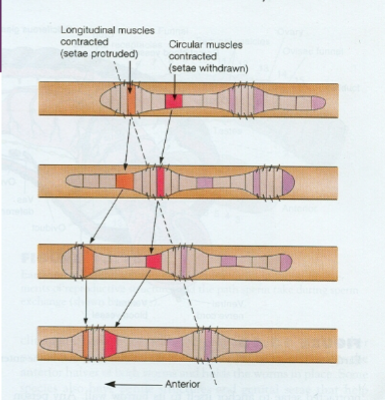
Annelid: Class Clintellata: Subclass Oligiochaeta locomotion
Move using peristaltic motion, a wave like movement produced by muscles and aided by bristles
The move by alternating contractions of circular and longitudinal muscles, using setae to grip the soil and propel themselves forward in a wave like motion.

Annelid: Class Clintellata: Subclass Oligiochaeta Digestion
Complete digestive tract specialized for processing soil and organic matter.
Mouth takes in soil—>Pharynx helps suck in food—>Esophagus transport food—>Crop stores food temporarily—>Gizzard grinds food—>intestine digests and absorbs nutrients—>Anus expels digested waste.
Calciferous gland is found in the esophagus, glands that help regulate calcium levels in the body
Annelid: Class Clintellata: Subclass Oligiochaeta Body systems
Gas Exchange: Diffusion Across body wall as they have no lungs or gills. Oxygen and co2 exits directly through moist body surface
Circulatory: Closed system with dorsal (pumps blood forward) & ventral vessels (carries blood backwards). Aortic arches (hearts) pump blood between vessels. Blood contains hemoglobin.
Nervous: Simple. Ganglia is connected to paired ventral nerve cord. Each segment has paired segmental ganglia for local control. Sensitive to light, touch, vibrations, and chemicals.
Sensory: Organs reduced, no developed eyes, sensory structures over body surface
Reproduction: Monoecious, sperm exchange during copulation, clitellum forms mucus for cocoon for eggs, direct development
Annelid: Class Clintellata: Subclass Hirudinea
500 species
Leeches
Freshwater, marine terrestrial
34 body segments
Setae reduced or absent
Dorso ventrally flattened
Feed on small invertebrates or body fluids of vertebrates
Leech locomotion
Move by inching itself forward, worm style of movement
Annelid: Class Clintellata: Subclass Hirudinea Body System
Gas exchange: Diffusion
Circulation: Sinus replace vessels, coelomic fluid takes on blood function, no respiratory pigments
Nervous: 10-17 pair of highly modified metanephridia. simple brain (ganglia) a ventral nerve cord along the body, nerve cord has segmental ganglia.
Reproduction: Monoecious, clitellum, sperm exchange during copulation, clitellum forms mucus for cocoon for eggs, direct development
What is a chordata?
Subphylum Craniata
Infraphylum Vertebrata
Group derived from cephalochordate lineage, they have a skull, 3 part brain, includes all vertebrate groups (fish, bird, mammals)
Vertebrate Origins
Derived from a cephalochordate-like ancestor, the earliest possible were conodonts which are jawless creatures considered among the first craniates. Oldest craniate fossil dates back to 530 MYA. Adaptive radiation of fish is the rapid diversification into many forms began around 500-750 MYA. Bone first appeared around 500 mya, contributing to vertebrate complexity.
Phylum Chordata Characteristics
45,000 species
Vertebrae made of cartilage or bone
Endoskeleton
Brain in protective chamber cartilage or bone
Closed circulatory system
High degree of cephalization (brains)
Sexual reproduction
Vertebrate Advantage
Fast reaction time and movement
Nervous system structure and neuron structure
High pressure closed circulatory system, high o2 delivery
Jointed endoskeleton and segmented muscles
Phylum Chordata: Superclass Gnathostomata (jaws)
Evolutionary group within chordata.
Chondrichthyes: sharks, rays, cartilaginous fish
Bony fish (Actinopterygii) ray finned, and (Sarcopterygii) lobe finned fish and tetrapod
Tetrapod: amphibians, reptiles, birds, mammal
Jaws evolved from gill arches which allows animals to bite, grasp, chew (expand feeding options)
Paired appendages, fins or limbs that appeared in pairs which improve movement and balance
Enhanced sensory system: well developed eyes, olfactory organs, and inner ears. In aquatic species they have a lateral line
Vertebral column: backbone made of vertebrae protecting the spinal cord
Mineralized tissues (bones and teeth) offer structural support and defense

What are placoid scales in cartilaginous fishes (chondrithyes)
Small tooth like scales found on skin of cartilaginous fish
Provide protection from predators and parasites
Phylum Chordata: Class Chondrichthyes
820 species
Shark, skates, rays
Skeleton made of cartilage
Placoid scales
Scavengers and predators
Ancient lineage
Shark teeth and jaw structure
Teeth are modified placoid scales
Conveyor belt arrangement
Jaw made of cartilage covered tesserae
Bony fish characteristics
Most abundant and diverse group
Bony skeleton
Lungs or swim bladder
operculum cover
Two chambered heart
Class Actinopterygii
Ray finned fish
swim bladderes
gas filled bladder that regulates buoyancy
chondrostean ancestor
Class Sarcopterygii
Lobe finned fish: fin bases are thick, muscular with bone supports
Lung: breath air
tetrapods
Class actinopterygii infraclass teleostei
Teleosts are so successful because they have an effiicient gas exchange system, locomotion system, sensory system, lateral line system, reproductive system.
Actinopterygii Digestive system
Actinopterygii have a complete digestive system with mouth, stomach, intestine, and pyloric caeca for efficient digestion adapted to diverse diets.
actinopterygii circulation system
Ray-finned fish have a closed circulatory system with a two-chambered heart and single blood circuit passing through gills for oxygenation before reaching the body.
Heart→Gill→Body→back to heart
actinopterygii gas exchange system
Ray-finned fish breathe by passing water over gills where oxygen diffuses into the blood via a counter-current system, making gas exchange very efficient.
actinopterygii nervous system
Ray-finned fish have a complex nervous system with a well-developed brain, sensory organs like lateral line, eyes, and olfactory organs, allowing them to sense and respond to their environment effectively.
Actinopterygii reproduction system
Ray-finned fish typically reproduce sexually with external fertilization, producing many eggs, though some have internal fertilization and parental care. They are dioecious
Actinopterygii excretion/osmoregulation system
Ray-finned fish excrete ammonia and regulate water and salt balance differently depending on their habitat—freshwater species dilute urine to remove excess water, while marine species conserve water and excrete salts.